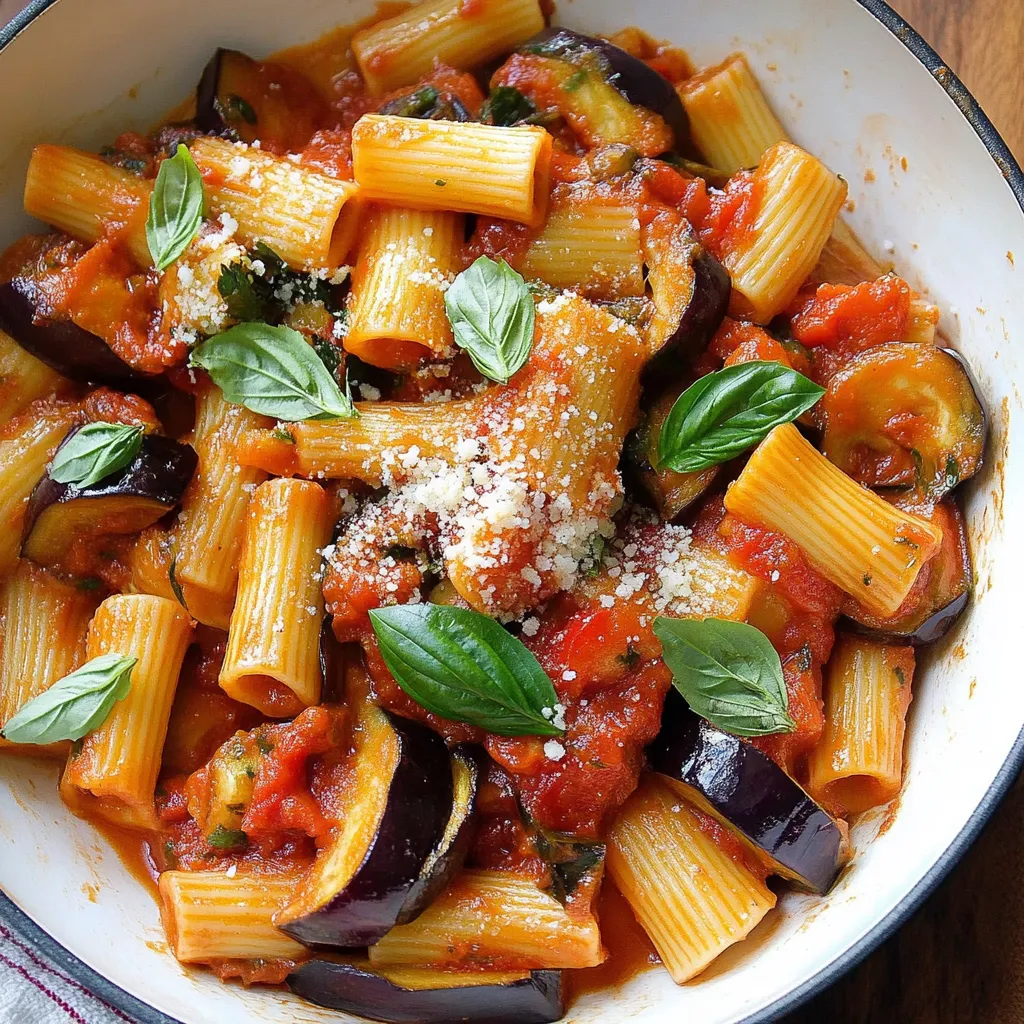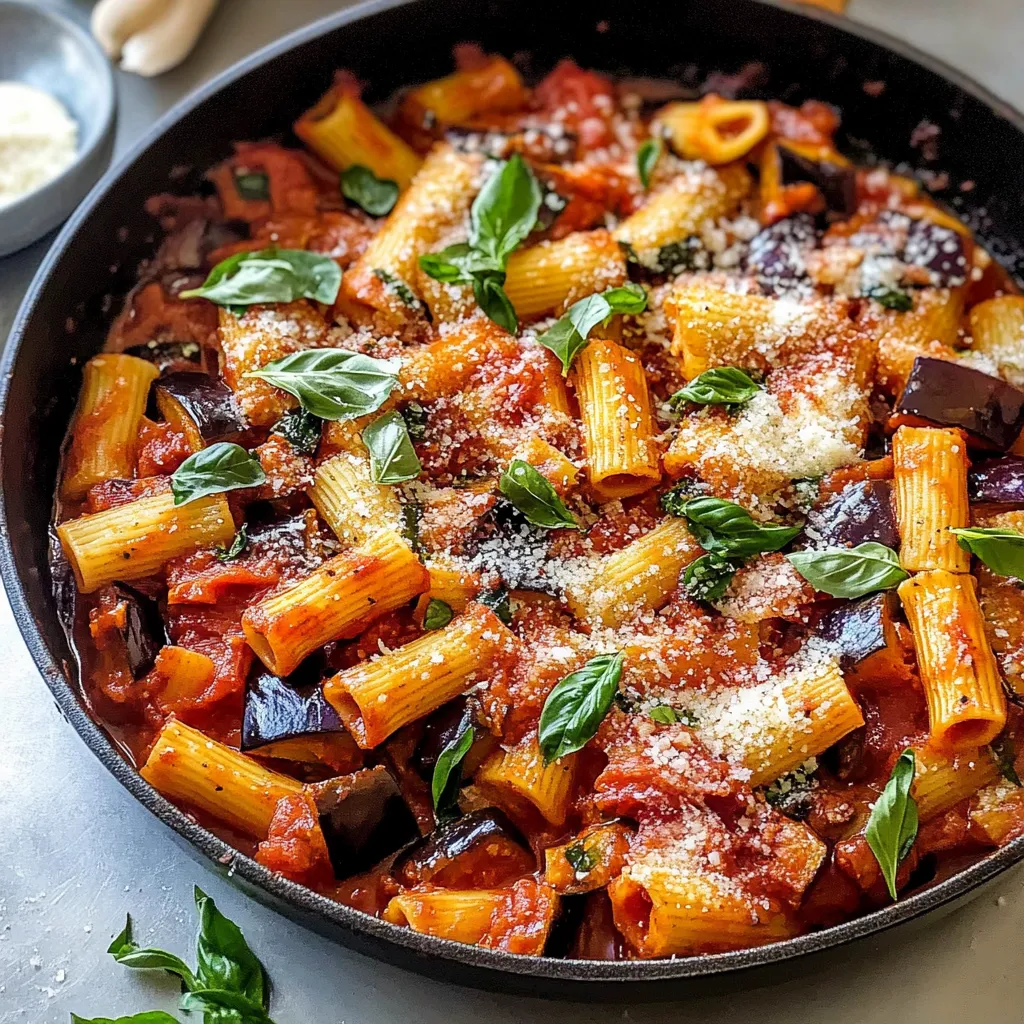 Pin it
Pin it
This hearty Sicilian pasta alla Norma transforms humble eggplant into a deeply satisfying meal that tastes like summer in Italy. The roasted eggplant adds a sweet, caramelized depth that beautifully complements the homemade marinara for a restaurant-quality dinner right at home.
I first discovered pasta alla Norma during a trip to Sicily, and it's become my go-to dinner party recipe. Guests always ask for seconds and are shocked when I reveal how simple it is to prepare at home.
Ingredients
- Globe eggplant: The star ingredient that gives this dish its character. Look for firm eggplants with smooth, shiny skin
- Rigatoni pasta: The tubular shape captures sauce beautifully. The ridges on rigatoni hold onto the sauce better than smooth pasta shapes
- San Marzano tomatoes: These Italian plum tomatoes have the ideal balance of sweetness and acidity. Worth the extra cost for the superior flavor
- Ricotta salata: A pressed, salted ricotta that adds wonderful tangy notes. The authentic choice, but pecorino or cotija make excellent substitutes
- Fresh basil: Adds brightness that cuts through the richness. Use only fresh, never dried, for this recipe
- Garlic cloves: Smashed rather than minced to infuse the oil gently without burning
- Extra virgin olive oil: Use your best quality oil as its flavor is prominent in the final dish
- Red pepper flakes: Provides a subtle heat that balances the sweet eggplant
Step-by-Step Instructions
- Prepare the marinara base:
- Crush whole tomatoes by hand for the perfect rustic texture. This manual method gives you control over the final consistency unlike using puréed tomatoes.
- Infuse the olive oil:
- Slowly cook garlic in olive oil until golden but not brown, about 5 minutes. This infuses the oil with rich garlic flavor while removing the aggressive raw bite. Keep the heat moderate to prevent burning, which would make the sauce bitter.
- Build the sauce foundation:
- Add tomato paste to the garlic oil and cook briefly to caramelize its sugars. This crucial step adds concentrated umami depth that makes homemade sauce taste professional. When adding tomatoes to the hot oil, stand back to avoid painful splatters.
- Simmer the marinara:
- Let the sauce bubble gently for 30 minutes with basil sprigs. This slow cooking develops complex flavors as the ingredients meld together. The oil that rises to the top contains tremendous flavor so stir it back in rather than removing it.
- Roast the eggplant:
- Cut eggplant into half-moon slices and arrange on oiled baking sheets. Roasting at high heat dehydrates the eggplant while concentrating its flavor, avoiding the oil-soaked result of traditional frying methods. Look for golden brown edges which indicate proper caramelization.
- Cook the pasta:
- Boil rigatoni in properly salted water until just al dente, slightly firmer than you might normally prefer. The pasta will continue cooking slightly when combined with the hot sauce. Reserve pasta water before draining as its starchy quality helps bind the sauce.
- Combine and finish:
- Toss everything together in the still-hot pasta pot, adding pasta water gradually to create a silky sauce that clings to each piece. The starchy pasta water acts as an emulsifier that brings the olive oil and tomato sauce together into a cohesive coating.
 Pin it
Pin it
My grandmother taught me to smash rather than mince the garlic for the sauce, insisting it created a more gentle, aromatic flavor. She'd say "cooking is not just about taste, but about patience" as we'd wait for the sauce to develop its rich flavor profile.
The Eggplant Question
Many traditional recipes call for salting and draining eggplant before cooking, a technique meant to draw out bitterness. Modern cultivated eggplants have had most bitterness bred out, making this step largely unnecessary. Roasting also eliminates any remaining bitter notes through caramelization. Skip the salting step to save time without sacrificing flavor.
Cheese Considerations
Authentic pasta alla Norma uses ricotta salata, a pressed and salted ricotta cheese with a firm texture and briny flavor. If unavailable, pecorino romano provides similar saltiness while cotija offers comparable texture. Fresh mozzarella can work in a pinch but changes the character of the dish to something creamier rather than tangy. Whatever cheese you choose, add it just before serving so it retains its distinct texture.
Make-Ahead Options
This dish shines as a make-ahead meal. The sauce can be prepared up to five days in advance and refrigerated, actually improving in flavor over time. Roasted eggplant can be prepared a day ahead, though it will soften slightly when reheated. For optimal texture, assemble everything just before serving, reheating the components separately before combining. Leftovers reheat beautifully in a covered skillet with a splash of water.
 Pin it
Pin it
With patience and thoughtful preparation, this pasta alla Norma rewards you with flavors that feel like a warm embrace straight from Sicily.
Frequently Asked Questions
- → What can I substitute for ricotta salata cheese?
If ricotta salata is unavailable, pecorino or cotija cheese make excellent substitutes as they provide similar saltiness. For a different but delicious option, torn fresh mozzarella works well, though it has a milder flavor profile than the traditional sheep's milk cheese.
- → Can I use jarred marinara sauce instead of homemade?
Yes, you can substitute 2 cups of high-quality jarred marinara sauce to save time. The homemade version provides optimal flavor, but a good store-bought alternative will still produce delicious results.
- → How do I prevent the eggplant from becoming soggy?
Roasting the eggplant at high temperature (425°F) instead of frying ensures better texture. Make sure to arrange eggplant pieces in a single layer on the sheet pan, don't overcrowd them, and roast until golden brown (about 30 minutes) for the best texture.
- → What pasta shape works best for Pasta alla Norma?
Rigatoni is traditional and ideal because its tubular shape with ridges captures the sauce and small pieces of eggplant. Other short pasta shapes like penne, ziti, or casarecce would also work well as alternatives.
- → Why do you crush whole tomatoes rather than using crushed tomatoes?
Hand-crushing whole peeled San Marzano tomatoes allows you to control the texture of the sauce, creating a more rustic consistency with varied pieces rather than the uniform texture of pre-crushed tomatoes. This method also typically yields better flavor as whole tomatoes are often higher quality.
- → How spicy is this dish with the red pepper flakes?
The recipe uses ¼ teaspoon of red pepper flakes which adds a mild warmth rather than significant heat. You can adjust to taste—increase for more spice or reduce/omit for a milder dish that's suitable for those who prefer less heat.
